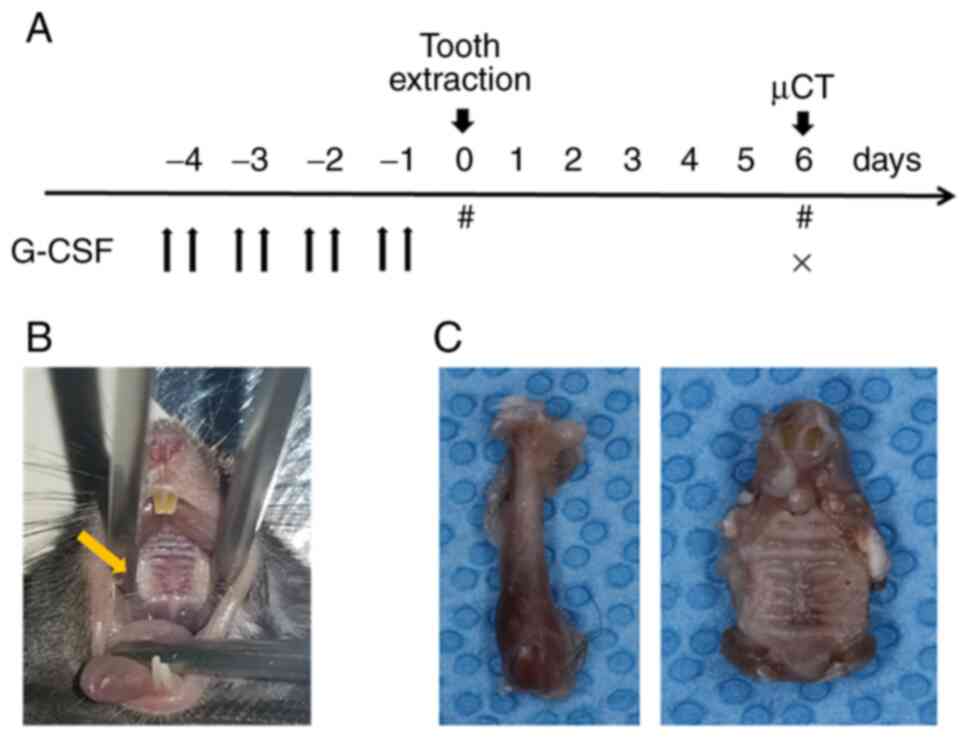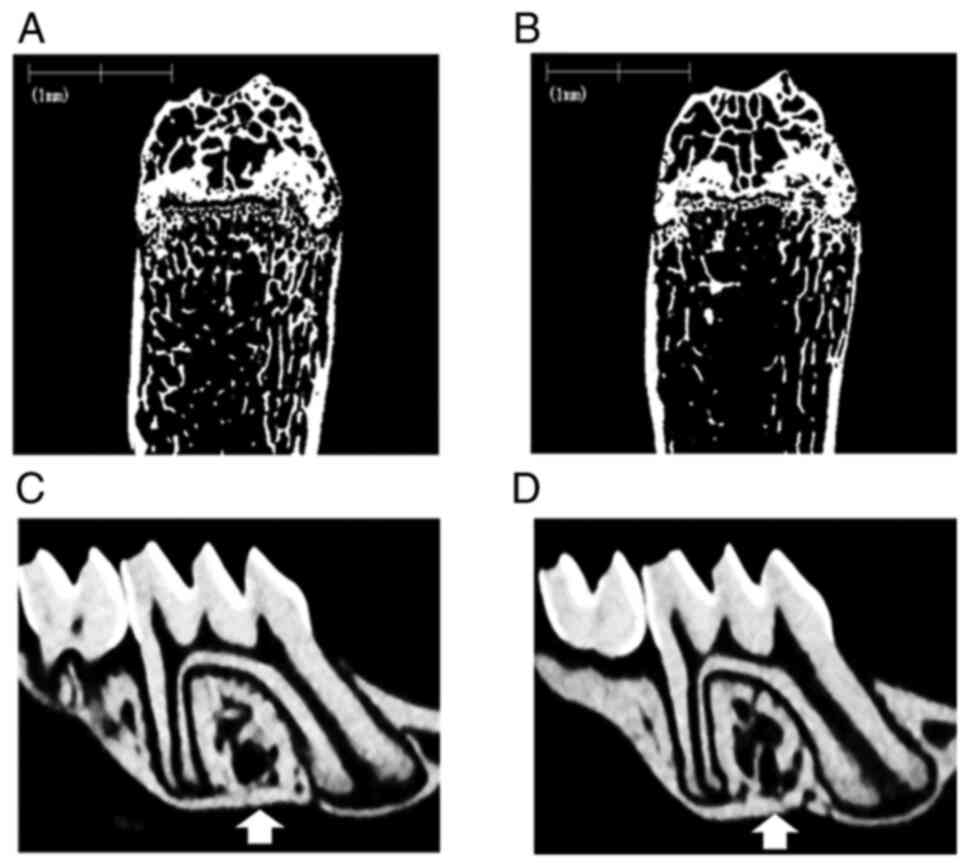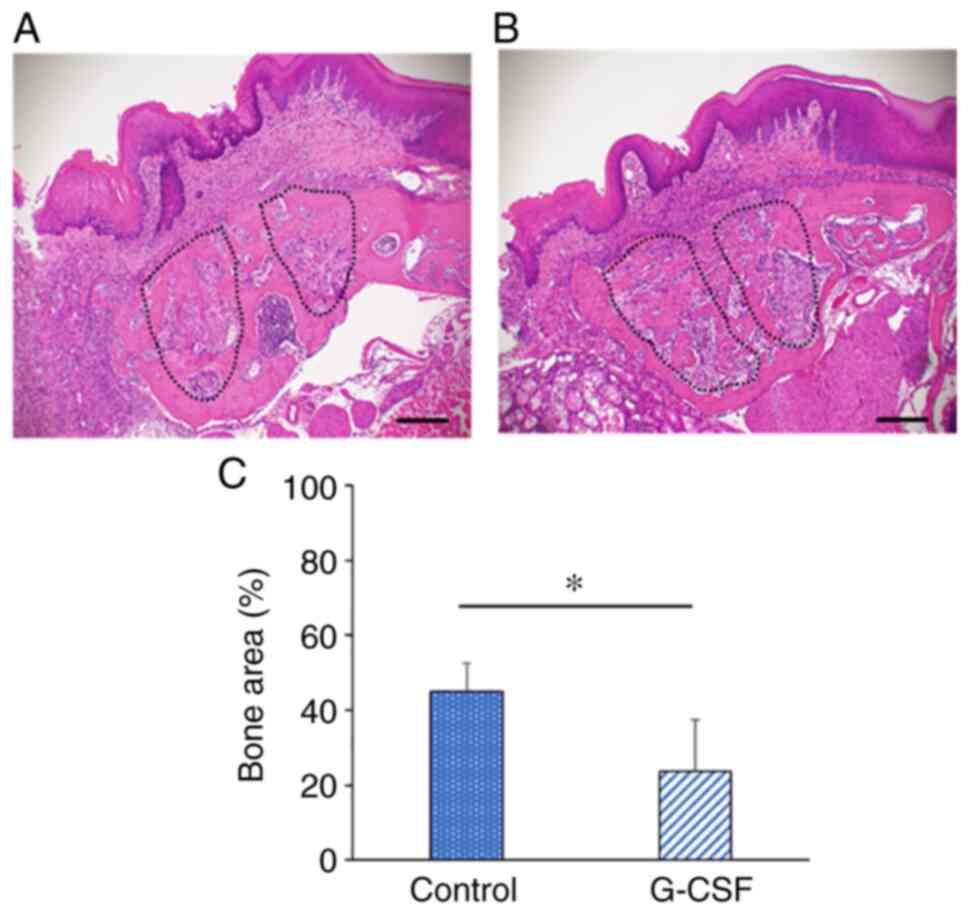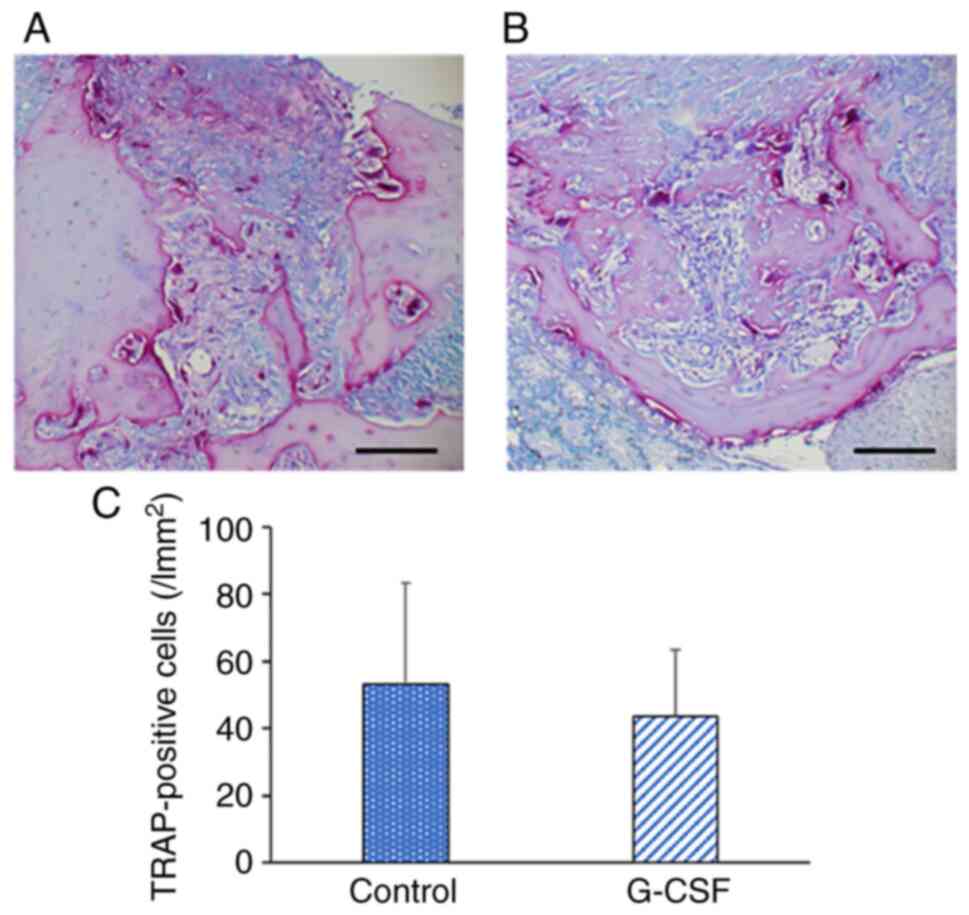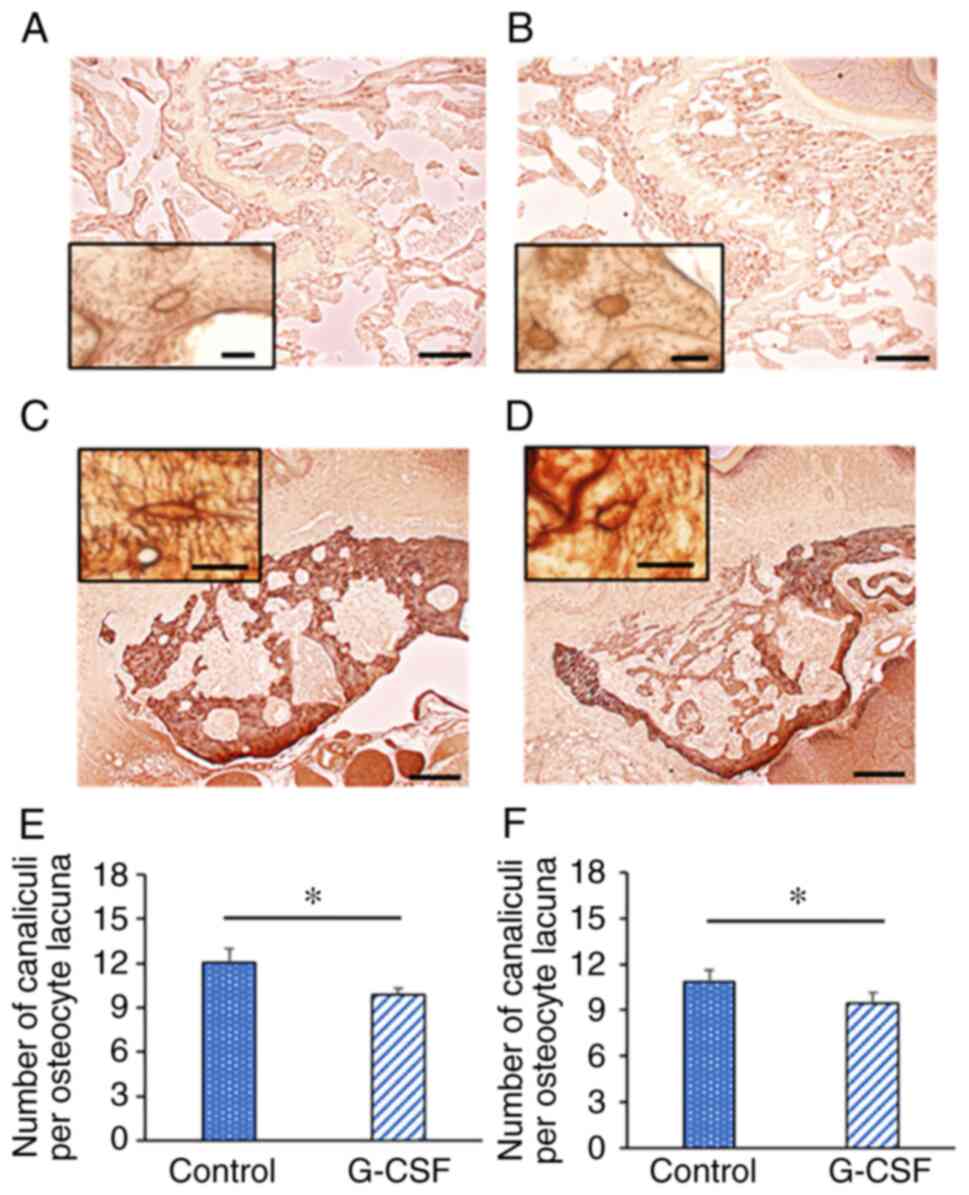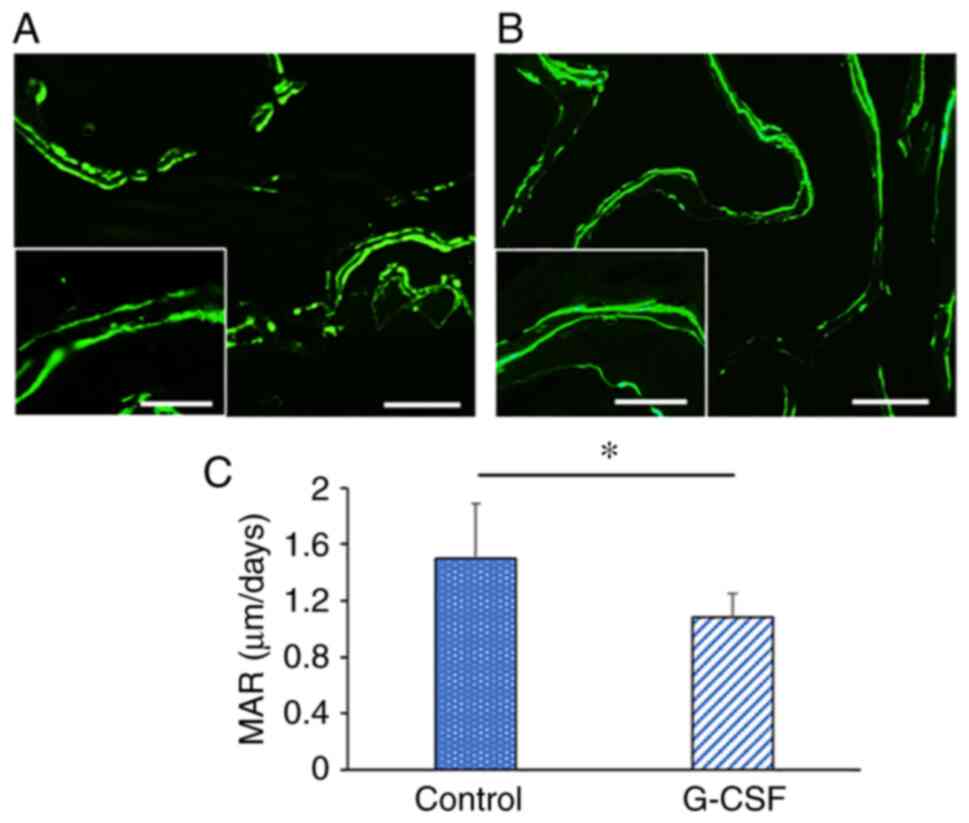|
1
|
Hübel K and Engert A: Clinical
applications of granulocyte colony-stimulating factor: An update
and summary. Ann Hematol. 82:207–213. 2003.PubMed/NCBI View Article : Google Scholar
|
|
2
|
Turhan AB, Binay C, Bor O and Simsek E:
The effects of short-term use of granulocyte colony-stimulating
factor on bone metabolism in child cancer patients. North Clin
Istanb. 5:277–281. 2018.PubMed/NCBI View Article : Google Scholar
|
|
3
|
Bendall LJ and Bradstock KF: G-CSF: From
granulopoietic stimulant to bone marrow stem cell mobilizing agent.
Cytokine Growth Factor Rev. 25:355–367. 2014.PubMed/NCBI View Article : Google Scholar
|
|
4
|
Asada N, Katayama Y, Sato M, Minagawa K,
Wakahashi K, Kawano H, Kawano Y, Sada A, Ikeda K, Matsui T and
Tanimoto M: Matrix-embedded osteocytes regulate mobilization of
hematopoietic stem/progenitor cells. Cell Stem Cell. 12:737–747.
2013.PubMed/NCBI View Article : Google Scholar
|
|
5
|
Lévesque JP, Hendy J, Takamatsu Y, Simmons
PJ and Bendall LJ: Disruption of the CXCR4/CXCL12 chemotactic
interaction during hematopoietic stem cell mobilization induced by
GCSF or cyclophosphamide. J Clin Invest. 111:187–196.
2003.PubMed/NCBI View
Article : Google Scholar
|
|
6
|
Semerad CL, Christopher MJ, Liu F, Short
B, Simmons PJ, Winkler I, Levesque JP, Chappel J, Ross FP and Link
DC: G-CSF potently inhibits osteoblast activity and CXCL12 mRNA
expression in the bone marrow. Blood. 106:3020–3027.
2005.PubMed/NCBI View Article : Google Scholar
|
|
7
|
Katsimbri P: The biology of normal bone
remodelling. Eur J Cancer Care (Engl). 26(e12740)2017.PubMed/NCBI View Article : Google Scholar
|
|
8
|
Hadjidakis DJ and Androulakis II: Bone
remodeling. Ann N Y Acad Sci. 1092:385–396. 2006.PubMed/NCBI View Article : Google Scholar
|
|
9
|
Takamatsu Y, Simmons PJ, Moore RJ, Morris
HA, To LB and Lévesque JP: Osteoclast-mediated bone resorption is
stimulated during short-term administration of granulocyte
colony-stimulating factor but is not responsible for hematopoietic
progenitor cell mobilization. Blood. 92:3465–3473. 1998.PubMed/NCBI
|
|
10
|
Watanabe T, Suzuya H, Onishi T, Kanai S,
Kaneko M, Watanabe H, Nakagawa R, Kawano Y, Takaue Y, Kuroda Y and
Talmadge JE: Effect of granulocyte colony-stimulating factor on
bone metabolism during peripheral blood stem cell mobilization. Int
J Hematol. 77:75–81. 2003.PubMed/NCBI View Article : Google Scholar
|
|
11
|
Bonilla MA, Dale D, Zeidler C, Last L,
Reiter A, Ruggeiro M, Davis M, Koci B, Hammond W, Gillio A and
Welte K: Long-term safety of treatment with recombinant human
granulocyte colony-stimulating factor (r-metHuG-CSF) in patients
with severe congenital neutropenias. Br J Haematol. 88:723–730.
1994.PubMed/NCBI View Article : Google Scholar
|
|
12
|
Bishop NJ, Williams DM, Compston JC,
Stirling DM and Prentice A: Osteoporosis in severe congenital
neutropenia treated with granulocyte colony-stimulating factor. Br
J Haematol. 89:927–928. 1995.PubMed/NCBI View Article : Google Scholar
|
|
13
|
Soshi S, Takahashi HE, Tanizawa T, Endo N,
Fujimoto R and Murota K: Effect of recombinant human granulocyte
colony-stimulating factor (rh G-CSF) on rat bone: Inhibition of
bone formation at the endosteal surface of vertebra and tibia.
Calcif Tissue Int. 58:337–340. 1996.PubMed/NCBI View Article : Google Scholar
|
|
14
|
Wu YD, Chien CH, Chao YJ, Hamrick MW, Hill
WD, Yu JC and Li X: Granulocyte colony-stimulating factor
administration alters femoral biomechanical properties in C57BL/6
mice. J Biomed Mater Res A. 87:972–979. 2008.PubMed/NCBI View Article : Google Scholar
|
|
15
|
Kishimoto H, Noguchi K and Takaoka K:
Novel insight into the management of bisphosphonate-related
osteonecrosis of the jaw (BRONJ). Jpn Dent Sci Rev. 55:95–102.
2019.PubMed/NCBI View Article : Google Scholar
|
|
16
|
Shudo A, Kishimoto H, Takaoka K and
Noguchi K: Long-term oral bisphosphonates delay healing after tooth
extraction: A single institutional prospective study. Osteoporos
Int. 29:2315–2321. 2018.PubMed/NCBI View Article : Google Scholar
|
|
17
|
Tamaoka J, Takaoka K, Hattori H, Ueta M,
Maeda H, Yamamura M, Yamanegi K, Noguchi K and Kishimoto H:
Osteonecrosis of the jaws caused by bisphosphonate treatment and
oxidative stress in mice. Exp Ther Med. 17:1440–1448.
2019.PubMed/NCBI View Article : Google Scholar
|
|
18
|
Takaoka K, Yamamura M, Nishioka T, Abe T,
Tamaoka J, Segawa E, Shinohara M, Ueda H, Kishimoto H and Urade M:
Establishment of an animal model of bisphosphonate-related
osteonecrosis of the jaws in spontaneously diabetic torii rats.
PLoS One. 14(e0144355)2015.PubMed/NCBI View Article : Google Scholar
|
|
19
|
Dempster DW, Compston JE, Drezner MK,
Glorieux FH, Kanis JA, Malluche H, Meunier PJ, Ott SM, Recker RR
and Parfitt AM: Standardized nomenclature, symbols, and units for
bone histomorphometry: A 2012 update of the report of the ASBMR
histomorphometry nomenclature committee. J Bone Miner Res. 28:2–17.
2013.PubMed/NCBI View Article : Google Scholar
|
|
20
|
Feng X and McDonald JM: Disorders of bone
remodeling. Annu Rev Pathol. 6:121–145. 2011.PubMed/NCBI View Article : Google Scholar
|
|
21
|
Khosla S and Monroe DG: Regulation of bone
metabolism by sex steroids. Cold Spring Harb Perspect Med.
8(a031211)2018.PubMed/NCBI View Article : Google Scholar
|
|
22
|
Wein MN and Kronenberg HM: Regulation of
bone remodeling by parathyroid hormone. Cold Spring Harb Perspect
Med. 8(a031237)2018.PubMed/NCBI View Article : Google Scholar
|
|
23
|
Zou ML, Chen ZH, Teng YY, Liu SY, Jia Y,
Zhang KW, Sun ZL, Wu JJ, Yuan ZD, Feng Y, et al: The smad dependent
TGF-β and BMP signaling pathway in bone remodeling and therapies.
Front Mol Biosci. 8(593310)2021.PubMed/NCBI View Article : Google Scholar
|
|
24
|
Siddiqui JA and Partridge NC:
Physiological bone remodeling: Systemic regulation and growth
factor involvement. Physiology (Bethesda). 31:233–245.
2016.PubMed/NCBI View Article : Google Scholar
|
|
25
|
Li SD, Chen YB, Qiu LG and Qin MQ: G-CSF
indirectly induces apoptosis of osteoblasts during hematopoietic
stem cell mobilization. Clin Transl Sci. 10:287–291.
2017.PubMed/NCBI View Article : Google Scholar
|
|
26
|
Tonna EA: Histological age changes
associated with mouse parodontal tissues. J Gerontol. 28:1–12.
1973.PubMed/NCBI View Article : Google Scholar
|
|
27
|
Matteini F, Mulaw MA and Florian MC: Aging
of the hematopoietic stem cell niche: New tools to answer an old
question. Front Immunol. 12(738204)2021.PubMed/NCBI View Article : Google Scholar
|
|
28
|
Wang JY, Huo L, Yu RQ, Rao NJ, Lu WW and
Zheng LW: Skeletal site-specific response of jawbones and long
bones to surgical interventions in rats treated with zoledronic
acid. Biomed Res Int. 2019(5138175)2019.PubMed/NCBI View Article : Google Scholar
|
|
29
|
Pan J, Pilawski I, Yuan X, Arioka M, Ticha
P, Tian Y and Helms JA: Interspecies comparison of alveolar bone
biology: Tooth extraction socket healing in mini pigs and mice. J
Periodontol. 91:1653–1663. 2020.PubMed/NCBI View Article : Google Scholar
|
|
30
|
Bonewald LF: Osteocytes as dynamic
multifunctional cells. Ann N Y Acad Sci. 1116:281–290.
2007.PubMed/NCBI View Article : Google Scholar
|
|
31
|
Kitaura H, Marahleh A, Ohori F, Noguchi T,
Shen WR, Qi J, Nara Y, Pramusita A, Kinjo R and Mizoguchi I:
Osteocyte-related cytokines regulate osteoclast formation and bone
resorption. Int J Mol Sci. 21(5169)2020.PubMed/NCBI View Article : Google Scholar
|















